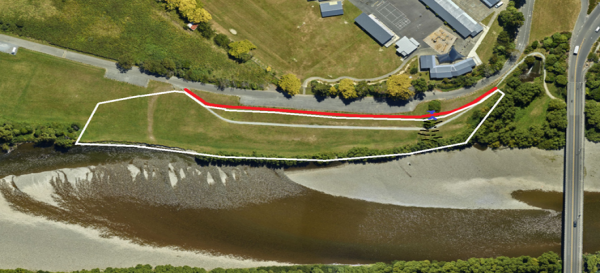River protection
Riverbank protection work coming to Belmont
Starting in July 2025, Greater Wellington will be carrying out important flood protection work along Te Awa Kairangi/ Hutt River where it passes the back of Belmont School (see affected area below).
This stretch of the riverbank is vulnerable to erosion which could eventually put infrastructure, open space, and public safety at risk. The work will help prevent lateral erosion (where the river eats into the land sideways). Strengthening it now helps protect the community well into the future.
What’s planned:
- a new culvert near the school carpark
- realignment of Speedy Stream and creation of a small riverside beach
- lowering the grassy berm to new design levels.
What you will see:
- some car park bays at the rear of Belmont School will be temporarily closed
- fenced-off work zones at the rear of Belmont School, and safety signage
- heavy machinery on-site from 7:30am–6:00pm, Monday to Saturday
- temporary restrictions to parts of the Hutt River Trail.

Key:
Red line = new walkway
White line: works area
Blue line: new culvert
Once we’ve completed these steps we’ll finish the project with bioengineering at the river’s edge. This is a nature-based method that uses bundles of felled willows anchored underwater. Once submerged, the felled trees will begin to resprout and support the river edge naturally. Willows will be sourced from two sites on either side of Te Awa Kairangi at Melling. This work will take place in August 2025.
To accommodate the tree felling Melling Bridge will be closed to all traffic between 9pm-5am over five consecutive nights from 12 to 18 August (weather permitting).
There will be intermittent escorted access for pedestrians and cyclists. However, we would advise those planning to use this bridge between 9pm- 5am to consider alternate routes on these nights.
Block Road will also be closed in both directions between from 12 - 21 August 2025 from 9pm – 5am. Pedestrian and cyclist movements on the adjacent trail will be catered for under escort. Detours for both road closures will be signposted.
We've used two methods to protect the edges of Te Awa Kairangi / Hutt River against flooding.
Hard edge protection
In the first half of 2025 we placed over 22,000 tonnes of rock along the river between Kennedy Good and Melling Link bridges, in areas where the river runs close to roads, substations or other important structure, such as the new stopbank at Mills Street.
We’ve used rocks that are 0.4m to 1.4m in diameter as they needed to be large enough to withstand the river’s force when it’s in flood. They are a dense crystalline marble with trace quartz and woolstonite veins.
Other common methods, such as big wire baskets full of smaller stones wouldn’t work here. They'd get smashed up by the debris that comes downstream with the force of the water.
Soft edge protection
In other areas, we’ve created soft edge protection, to slow down the velocity of the water and create a natural habitat for river life. We’ve laid horizontal bundles of willows that we harvested to make way for the rock lines.
They're anchored by large concrete blocks buried under the beach and tied in place with biodegradable manila rope.
The uprooted trees stay in contact with the water and sprout quickly. They eventually grow into a natural river berm on the pebbly beach, known as a groyne.
As well as willow bundles, we've also planted willow poles, which provide a double duty as stabilisers. They slow floodwater over the berms and are angled to help reroute flood water to the river.
Check out this video showing how our soft edge protection is done.
Transition to natives
Willows have been used in New Zealand since the 1840s to manage rivers. In future, we intend to transition to natives between Kennedy Good and Melling Link bridges.
We’ve been running a trial to see which natives might thrive, and testing various planting supports, such as wooden root pegs, wool bags, biodegradable plant guards and wool mats.
In the test area, 18 species have been planted out among young willows, which provide shade as well as slowing down the floodwater. The natives have survived four floods since they were planted in August 2024.

